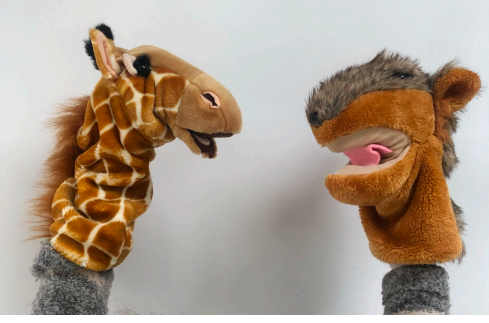By Janet Kaufman
Word on the Street Issue 41, March 2024
. . .
In the evenings, youth in the middle-school grades at Interfaith meet to spend time together, reflect on their days, and enjoy creative learning. We call our group the “Giraffe Group.”
Through art and discussion, we’ve been practicing elements of compassionate communication, meaning speaking to others and ourselves with understanding and empathy. When we do this, we’re able to keep peace, nurture our relationships, and solve problems and conflicts with more ease.
Two helpful metaphors from Nonviolent Communication add playfulness to our study of compassionate communication in the form of two animals: the giraffe and the jackal.
The jackal is a predatory animal. To eat and satisfy its hunger, it attacks. When people experience the “jackal” part of them, they may demand, make judgments, or speak in “shoulds” or“shouldn’ts.” The jackal represents a part of us that wants to blame or attack others. It can cause small or large harms.
By contrast, the giraffe is the land mammal with the biggest heart (think of how far it has to pump blood, up to the giraffe’s head and all the way down to its feet!). Its long neck lets it see with perspective, far and wide. Its saliva softens thorns on plants so the giraffe can swallow them. The giraffe represents the part of us that can zoom out to see the big picture, soften harsh words or insults we experience to ease our hurt or fear, and speak with compassion. Speaking “giraffe,” we acknowledge or take responsibility for our feelings, needs, and actions, and we care for others by trying to understand and being curious about them.
In the Giraffe Group, we’ve made art to represent the jackal and giraffe, and to find expression for the warmth, kindness, and joy that we experience when people relate to each other with compassion. The paintings below represent group projects: about eight youth contributed to painting the portraits below of our friends the jackal and giraffe.

Sometimes people think the jackal is “bad” and the giraffe is “good.” On the surface, the jackal part of us often wants to change or control another person or situation, or get its own way. But if we pay attention, the jackal may be trying to convey something important. Perhaps it wants us to see that we feel helpless or powerless, so it tries to control a situation. Or perhaps it wants us to see that we are scared or worried, so it acts angry to try protecting us. If we listen to the jackal to hear what’s important to it, we may prevent harm.
That’s when we need the giraffe to step up to help. With its wide perspective and big heart, it can see worry, fear, or helplessness that we feel and reassure us. It can see that we may need safety, comfort, belonging, or acceptance. The giraffe helps us understand and empathize with
ourselves. By seeing feelings and needs that might be hiding underneath someone’s behavior, it softens harsh words. Though we understand that the jackal tries to communicate about important feelings and needs. The Giraffe Group has found that we enjoy speaking and hearing “giraffe language” much more.
In a challenging moment, when the jackal seems to be right in front of our face, it takes practice to turn our heads up to the giraffe, breathe, and listen deeply for feelings and needs. With our friends the puppets, and with art, we are learning to do just that.

